
|
Sale 31
Pre-Long Beach Coin Auction
| Lot |
Photo |
Description |
Realized |
Lot 2269 |
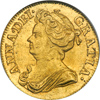 |
Great Britain. Guinea, 1714. S.3574; Fr-320; KM-534. Anne. After Union type, 3rd bust. A minor mark on the Queen's cheek keeps this piece from the gem category. Boldly struck and very choice, with fresh original luster. NGC graded MS-63.
Estimated Value $4,500 - 5,500.
The Cheshire Collection.
View details and enlarged photos
| Realized
$3,565 |
Lot 2270 |
|
Great Britain. Halfcrown, 1703 VIGO. Queen Anne. S-3580. Pre-Union reverse. Edge not visible in the slab but probably "TERTIO." Despite an unfortunate but mint-caused long adjustment vertically through the queen's hair (and a couple of minor ones beside it), this is an elegant coin! There is just a touch of wear from long ago. The strike is sharp. Luster gleams beneath beautiful, almost black toning which is enhanced by a luscious amber-mauve iridescence, strongest on the reverse. Abrasions are all small. So well-preserved that you can still see telltale die-work here and there around the devices. The obverse legend, and part of the reverse legend, show classic bifurcations at the bottoms of the letters, endemic of this coin's time in history. It was made from silver specie captured by Anglo-Dutch raids led by Sir George Rooke on Spanish coastal towns during the treacherous War of the Spanish Succession and ending in the Battle of Vigo Bay, where enemy treasure ships were looted of some eleven million "pieces of eight" that were subsequently melted by the Royal Mint and turned into this distinctive commemorative issue. Over the three centuries that have expired since these coins were made, most Vigos have perished, and a coin of this quality is indeed a rarity. NGC graded AU-55.
Estimated Value $2,000 - 2,250.
The Cheshire Collection.
View details
| Unsold |
Lot 2271 |
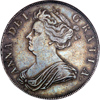 |
Great Britain. Halfcrown, 1704. S.3581; ESC-570 (Rarity-2). Anne. Plumes in angles. Well struck and deeply toned. This a rare date in a grade that's all but impossible to locate. NGC graded AU-55.
Estimated Value $2,000 - 2,500.
The Cheshire Collection.
View details and enlarged photos
| Realized
$2,300 |
Lot 2272 |
 |
Great Britain. Shilling, 1702. S.3583; ESC-1128. Anne. First bust. Plain in angles. Light gold and blue tone. Small marks on the portrait but still an attractive piece. Rare Pre-Union date! NGC graded MS-60.
Estimated Value $1,250 - 1,500.
The Cheshire Collection.
View details and enlarged photos
| Unsold |
Lot 2273 |
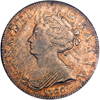 |
Great Britain. Shilling, 1703. S.3586; ESC-1131. Anne. Second bust, Vigo below. Lustrous with light golden tone. Unusually pleasing for a Vigo shilling! NGC graded MS-62.
Estimated Value $1,000 - 1,250.
The Cheshire Collection.
View details and enlarged photos
| Unsold |
Lot 2274 |
 |
Great Britain. Silver Shilling, 1705, Plumes. Queen Anne. S-3588. Second bust. Very rare! Pre-Union issue. Plumes in reverse field stand for so-called West County silver, specifically from the Welsh Copper Company, but they are also royal insignia favored by the Scots, so the traditional meaning that they denote only origin of the silver may not be entirely valid. This is a rare piece even in VF but here we have a coin graded AU58, which would be called "Good EF" in the homeland market. It's beautifully toned, bright blue and mauve and amber gold, with its base a lovely lilac gray. A few softly struck spots but overall a nice sharp coin with considerable "pizzazz" that's seldom found on these coins. In fact, the reverse in particular is so colorful that it's hard to stop looking at it. NGC graded AU-58.
Estimated Value $1,000 - 1,200.
The Cheshire Collection.
View details and enlarged photos
| Realized
$1,440 |
Lot 2275 |
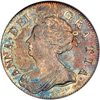 |
Great Britain. Silver Shilling, 1705, Roses & Plumes. Queen Anne. S-3589. Second bust. Hallmark insignia designate silver supplied by the Company for Smelting Down Lead. Scarce and popular issue, but in a grade which makes this a Very Rare coin. No discernible wear. Homeland die-hards will insist they see some rubbing on the high points, but is there any? A slight softness of detail, from striking, appears on the queen's hair and also on the top lion of the English shield on reverse. This is not wear. There could be a hint of cabinet friction on the queen's curls, but luster is abundant beneath an especially appealing pastel iridescence that includes silvery gray, amber gold, and greenish blue hues. A glitter is definitely showing, that does not exist except on Mint State coins. All in all, a most impressive and beautiful example of this distinctive coinage! NGC graded MS-63.
Estimated Value $1,400 - 1,700.
The Cheshire Collection.
View details and enlarged photos
| Realized
$1,610 |
Lot 2276 |
 |
Great Britain. Sixpence, 1705. S.3593; ESC-1584; KM-516.4. Anne. Late shields, plumes in reverse angles. This coin is flawless with superb original toning. A very elusive date never seen this nice. NGC graded MS-63.
Estimated Value $900 - 1,100.
The Cheshire Collection.
View details and enlarged photos
| Realized
$834 |
Lot 2277 |
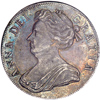 |
Great Britain. Crown, 1707. S.3601; ESC-104; Dav-1341. Anne. Edge, Septimo. Angles plain. Practically as struck, and free from the haymarking, blankfiling and other imperfections which plagued the silver coins of this reign. NGC graded AU-58.
Estimated Value $2,400 - 2,700.
The Cheshire Collection.
View details and enlarged photos
| Realized
$2,530 |
Lot 2278 |
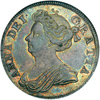 |
Great Britain. Halfcrown, 1708. Queen Anne. S-3604. Post-Union reverse, showing the re-arranged insignia of the shield, meant to hallmark the union of Scotland with the other kingdoms. Edge date not visible in the slab but probably "SEPTIMO." Here for your bidding pleasure in an incredible coin! A coin of exquisite eye-appeal, showing booming luster, almost flawless surfaces possessing an unusual sheen, a crisp strike, and vibrant iridescent toning giving off a rainbow of colors: golden amber, mauve, blue, even some sea-green! Anne's portrait is beautifully detailed, showing each curl of hair in detail. The reverse shield is a study in minting quality, crisp in each quadrant with sharp shields at the outsides and a fully struck radiant sun at the center. The cataloguer can recall perhaps six Anne halfcrowns equal to this specimen, all dated 1708, over a period of some 25 years of looking at England's best. Should be worth a bid far in excess of Spink catalogue value for an EF example ($1700), the highest grade listed in that price guide. NGC graded MS-64.
Estimated Value $3,500 - 4,000.
The Cheshire Collection.
View details and enlarged photos
| Realized
$4,025 |
Lot 2279 |
 |
Great Britain. Shilling, 1707. S.3610; ESC-1141. Anne. Angles plain. Well struck, fully lustrous with attractive deep amber-gray toning. Rare so fine. NGC graded MS-64.
Estimated Value $650 - 850.
The Cheshire Collection.
View details and enlarged photos
| Realized
$546 |
Lot 2280 |
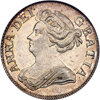 |
Great Britain. Shilling, 1708. S.3610; ESC-1147. Anne. Third bust. Angles plain. Lustrous with light gold toning and a sharp strike. Light mint-made adjustments on Anne's cheek. An especially fine example of this, the most often seen date. NGC graded MS-63.
Estimated Value $550 - 650.
The Cheshire Collection.
View details and enlarged photos
| Realized
$460 |
Lot 2281 |
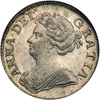 |
Great Britain. Shilling, 1708. S-3610; KM-523.1. Anne. Brilliant with very light haymarking. NGC graded MS-63.
Estimated Value $400 - 500.
View details and enlarged photos
| Realized
$374 |
Lot 2282 |
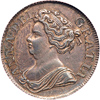 |
Great Britain. Shilling, 1712. S.3617; ESC-1159. Anne. Fourth bust. Roses and plumes in angles. Sharp strike, deeply toned with a trace of luster. NGC graded AU-58.
Estimated Value $1,000 - 1,250.
The Cheshire Collection.
View details and enlarged photos
| Realized
$810 |
Lot 2283 |
 |
Great Britain. Sixpence, 1707. S.3619; ESC-1587; KM-522.1. Anne. After Union with Scotland. Angles plain. Bold full strike with lovely old toning. NGC graded MS-65.
Estimated Value $750 - 1,000.
The Cheshire Collection.
View details and enlarged photos
| Realized
$930 |
Lot 2284 |
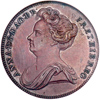 |
Great Britain. Pattern Halfpenny, Undated. Peck 730 (Very Rare). Struck in copper, this was one of the few specimens to have been given a superb bronzed finish. There is a nice red color to the coin. Striated edge. This coin has a reverse design of a rose with eight leaves and a thistle with two leaves, on a single stem- thereby signifying the (Act of) Union of England and Scotland in 1707. We cannot remember seeing a nicer example of this rare coin. Free from the usual reverse die rust marks. NGC graded MS-64 Brown.
Estimated Value $1,500 - 1,800.
The Cheshire Collection.
View details and enlarged photos
| Realized
$1,725 |
Lot 2285 |
 |
Great Britain. Pattern copper Halfpenny (1712-14. Queen Anne. P-728, rated Rare. Britannia reverse, large crown above the symbolic majesty. A truly lovely example, gleaming glossy surfaces showing only the faintest of hairlines. Die-rust evident on reverse, which has patches of what looks like cracked ice on a frozen pond. This is not "distracting" but rather interesting, as an insight into the die work of the era. This beautiful specimen is free from the defects, flaws and alloying problems so commonly seen on coppers of this time period. A finer example than has been held in most major collections, including Norweb. NGC graded Proof 64 Brown.
Estimated Value $1,600 - 2,000.
The Cheshire Collection.
View details and enlarged photos
| Unsold |
Lot 2286 |
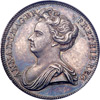 |
Great Britain. Pattern silver Halfpenny (1712-14). Queen Anne. Undated. Peck-727. 29 mm in diameter. Rated "extremely rare" by Peck. A lovely complement (Peck calls it "among the most attractive in the whole copper series") to the several silver pattern farthings in this sale, and all prospective bidders should review our comments about these issues made under those lots. This is a fascinating coin, made under the direction of mint master Sir Isaac Newton, one of the most notable of England's scientific thinkers of that age. Reverse features an early, sharply engraved Britannia motif, which in fact bears more than slight resemblance to Queen Anne herself, in facial features and body style. Above her, suspended in the air, a crown. The obverse portrait is sharply engraved. In this pattern we see a big step made by the Royal Mint towards more modern-looking copper coins, which were to come shortly in the reigns of George I and II, the first Hanovers. But in Anne's time the only issued coppers were the rare farthings of 1714. A series of patterns for the coming halfpenny was made, of which this is an excellent example. Peck claims (page 183) that this was struck during Anne's final year, or perhaps even shortly after her death, in 1714. Edge not viewable in the slab. Struck as a Proof, with striated edge, and should be labeled PR58. An ancient long scuff on the queen's cheek, and a number of tiny abrasions in the fields, but these are typical of early patterns and should not be seen as serious impairments in a 300-year-old coin. Double-struck reverse on the border, showing an entire extra row of denticles from 1 to 7 o'clock! Reflective surfaces remain, and the coin is blessed by gorgeous silver-gray toning with some sparkling iridescence, creating exceptionally fine eye-appeal. Peck believed that only 2 pieces were known to exist. NGC graded AU-58.
Estimated Value $3,250 - 3,500.
The Cheshire Collection.
View details and enlarged photos
| Unsold |
Lot 2287 |
 |
Great Britain. Pattern Farthing in silver, 1713. Queen Anne. Peck-746. Very rare. Britannia seated on globe, with shield below her left arm. Flan 23mm in diameter. Aside from the deeply toothed borders, and different placement of the date and reverse legend, this is the design ultimately used for the commercial copper issue of 1714 (S-3625). Most observers would argue that the later placement of the date within the exergue, rather than at the end of the legend as seen on this pattern, ultimately produced a neater and more balanced design, which is also to be seen on the example of P-758 in this collection. The first patterns of this exact style were struck in copper, and Peck labels the silver strikes with slight variation in the style of the obverse letters "pieces de plaisir," suggesting unusual experimentation at the mint. Rarely does the student of coins have a chance to compare a "linkage" of styles, as are presented in this collection, to literally view the design of a coin as it evolved through a variety of "thinking stages" to completion and final issuance to the public. Additionally, this is a beautiful specimen, a very choice example of light silver-gray toning enhanced by delightful "splashes" of iridescence. NGC graded Proof 64.
Estimated Value $2,750 - 3,000.
The Cheshire Collection.
View details and enlarged photos
| Unsold |
Lot 2288 |
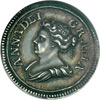 |
Great Britain. Pattern Farthing in silver, 1713. Queen Anne. Peck-747. Britannia seated on globe, with shield below her left arm as on previous patterns, but now within a niche or portico of archaeological perspective. Flan 23mm in diameter. Rated rare in any condition, this piece must figure among the nicer known examples. Two-tone medium and darker gray, offset by amber and blue iridescence. Deeply toothed borders, creating a dramatic "picture" on each side. The string of pearls binding up the queen's hair, mentioned by Peck on page 186, is particularly bold on this piece. In all, a pleasing example of one of the more imaginative patterns which led to the elusive copper farthing issue of 1714 (S-3625), which used this portrait of the queen and was struck shortly before Anne died without leaving an heir to the throne of England, as all of her numerous children tragically pre-deceased her, and also signaling the conclusion to the Stuart royal dynasty. NGC graded Proof 63.
Estimated Value $2,500 - 2,800.
The Cheshire Collection.
View details and enlarged photos
| Unsold |
Lot 2289 |
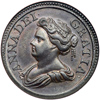 |
Great Britain. Copper Queen Anne Farthing, 1714. S-3625. P-741. Small flan. Normal Britannia reverse. This is the most seen variety of the famous Anne farthing but nevertheless it is quite scarce, especially so in this lovely condition. Light evident wear but glossy dark chocolate colored surfaces, only the tiniest of abrasions present, and on reverse a long faint crack filled in with ancient red wax. What a curious, and very handsome, piece this is! The obverse denticles are huge, producing a dramatic cameo appearance of the Queen. NGC graded AU-58 Brown.
Estimated Value $1,200 - 1,400.
The Cheshire Collection.
View details and enlarged photos
| Realized
$1,380 |
Lot 2290 |
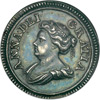 |
Great Britain. Pattern Farthing in silver, 1714. Queen Anne. Peck-758. Britannia seated on globe, but now her left arm is raised to hold the spear or trident at its upper end. Peck does not mention this, but the globe now has a different curl to its cartouche, which is also the version that appears on the commercial issue. Flan 23mm in diameter. Style as used for the 1714 copper pieces, showing bifurcated letters on "ANNA." This is a later issue, a so-called Restrike most probably made unofficially inside the Royal Mint, within 40 years of the queen's death. The likely reason was to satisfy collector demand for a rarity, but despite most authors' suggestions of wrongdoing it is probable that affection for the late monarch had much to do with any restriking activity. However you see it, this pattern remains very rare in any condition, and few could match the quality and eye-appeal of the Cheshire Collection specimen. Two-tone gray surfaces, with bluish amber iridescence. NGC graded Proof 63.
All interested collectors should take the time to read Peck's comments about the early British coppers, and particularly those of this monarch (see pages 175-179 and 186 in the 2nd edition of his classic reference) before bidding on any Anne patterns. Without his historical perspective, the coins are little more than crude curiosities. Reading about their origin brings them back to life, and infuses the coppers with a charm so frequently associated in American numismatics with the comments of Sheldon on copper cents of the 1790s to early 1800s. In particular, Peck revives the memory of the mint master of this era, Sir Isaac Newton, early scientist of the Age of Inquiry, explaining that Newton wished the royal coppers to be of such a consistent quality that they would be popularly regarded as something more than the traditional "subsidiary coinage" of little merit. The mint master's desire for purity also points to perhaps a new perspective on the patterns in gold and silver, that they are far more than mere pieces of caprice. Additionally, Peck provides some perspective on these coins from the contemporary public, and also comments that earlier numismatists' belief that the rare 1714 farthings, which many thought to be later-made mementos because few were ever seen well worn, were in fact made in 1714 and distributed for circulation, but kept as charms by Anne's subjects, who mourned her passing.
Estimated Value $2,000 - 2,400.
The Cheshire Collection.
View details and enlarged photos
| Unsold |
|
|